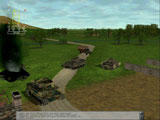 World War II tank simmers have
waited a long time for a realistic and fun simulation of armored combat during The Big
One. Though last year brought two offerings--SSI’s Panzer Commander and Interactive
Magic’s iPanzer ’44—both had serious shortcomings, and didn’t capture
the imagination of either casual gamers or the hardcore. This was especially rankling to
tank simmers when they considered the numerous quality World War II air combat sims that
appeared last year. Stuck without a decent game of their own, gamers could only look to
one slim remaining hope—Psygnosis and Wings Simulations’ long-delayed Panzer
Elite. Well, treadheads, look no further—Panzer
Elite is by far the best World War II tank sim ever—it’s realistic, it’s
fun, and it absolutely captures the “feel” of tank combat. That’s not to
say it doesn’t have some problems—it’s a little buggy out of the box, the
manual is inexcusably insufficient, the AI can be less than intelligent, and the graphics
are a mixed bag. But overall this is a superior game engine and a terrific game. World War II tank simmers have
waited a long time for a realistic and fun simulation of armored combat during The Big
One. Though last year brought two offerings--SSI’s Panzer Commander and Interactive
Magic’s iPanzer ’44—both had serious shortcomings, and didn’t capture
the imagination of either casual gamers or the hardcore. This was especially rankling to
tank simmers when they considered the numerous quality World War II air combat sims that
appeared last year. Stuck without a decent game of their own, gamers could only look to
one slim remaining hope—Psygnosis and Wings Simulations’ long-delayed Panzer
Elite. Well, treadheads, look no further—Panzer
Elite is by far the best World War II tank sim ever—it’s realistic, it’s
fun, and it absolutely captures the “feel” of tank combat. That’s not to
say it doesn’t have some problems—it’s a little buggy out of the box, the
manual is inexcusably insufficient, the AI can be less than intelligent, and the graphics
are a mixed bag. But overall this is a superior game engine and a terrific game. Panzer Elite allows you to play either
the German or the American side in three different, somewhat limited campaigns—one
focusing on the battle of Kasserine Pass in Tunisia, one made up of a collection of
battles from the Sicilian and Italian campaigns, and one covering the Normandy battles
from the St. Lo breakout. You can also play the 39 campaign scenarios individually, and
fight in “instant action” mode as well.
In most scenarios, you’ll find yourself in the command tank of a
tank platoon of 3-4 tanks, and your choice of tanks is also somewhat limited. As the
American, you’ll be able to command most of the Sherman variants; as the German, you’ll
pilot Panzer IVs, Panthers, and Tiger Is. You’ll see plenty of other tanks in the
game, from Hetzers to M-10s--just don’t expect to drive them.
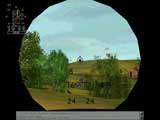 But Panzer Elite is an very
realistic game, and the tanks you do get are exquisitely modeled. Though you can play the
game at beginner level and still get a good feel for armored warfare, cranking the game up
to full realism and taking control of the various crew positions is an immensely
educational and immersive experience. As a gunner, you’ll find out just how difficult
it is too pick out targets while mastering the game’s spot-on gunnery optics; as the
tank commander, you’ll understand why such commanders preferred to fight without
buttoning up, and why it’s important to do so with enemy infantry around. As driver
you’ll learn to avoid steep inclines and to shift gears; as loader you’ll learn
to use the right ammo in the right situation and handle the machine gun; as radio operator
you can call in arty strikes. But the game is very customizable, and you can choose the
level of difficulty at which you wish to play. I imagine most will play from the tank
commander’s position, leaving the loader and gunner to aim and fire and the driver to
shift gears. But Panzer Elite is an very
realistic game, and the tanks you do get are exquisitely modeled. Though you can play the
game at beginner level and still get a good feel for armored warfare, cranking the game up
to full realism and taking control of the various crew positions is an immensely
educational and immersive experience. As a gunner, you’ll find out just how difficult
it is too pick out targets while mastering the game’s spot-on gunnery optics; as the
tank commander, you’ll understand why such commanders preferred to fight without
buttoning up, and why it’s important to do so with enemy infantry around. As driver
you’ll learn to avoid steep inclines and to shift gears; as loader you’ll learn
to use the right ammo in the right situation and handle the machine gun; as radio operator
you can call in arty strikes. But the game is very customizable, and you can choose the
level of difficulty at which you wish to play. I imagine most will play from the tank
commander’s position, leaving the loader and gunner to aim and fire and the driver to
shift gears.
And the game’s scenarios are
realistic and carefully-crafted as well. In most of them, your platoon will be given a
mission consisting of primary and secondary goals—usually something along the lines
of holding a town or turning back an enemy incursion. You’ll be supported by other
units, and while you have no control over them, they will keep you apprised of their
situation over the radio, and if you’re good and lucky, you can often coordinate
attacks with them. The missions take place over sprawling landscapes, and can take quite a
while to complete. This is no arcadey drop-you-right-into-the-action sim—you’ll
usually have to move to contact, which allows you a lot of freedom in the approaches and
positions you take.
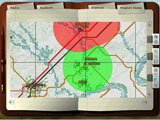 The
game’s graphics have their ups and downs. While the terrain is excellent, with plenty
of little depressions that offer opportunities to go hull-down and individual trees that
offer cover, it also shows a lot a seams. Likewise, tanks are very realistically modeled,
but also flash lots of seamage and can have clipping problems. Smoke and explosions are
very nicely done, and tanks even kick up dust as they negotiate dirt roads. Weather
effects are pretty portrayed as well; cloud effects are especially atmospheric, and while
raindrops are fairly rudimentary, they do the job of cutting down your sighting range. On
the other hand, infantry (which at least appears in the game, vice Panzer Commander) looks
downright goofy. Overall, the graphics are a
bit dated, but more than sufficient. Sound is very good, though I’ve had some
problems with voiceovers cutting our during mission briefings. The
game’s graphics have their ups and downs. While the terrain is excellent, with plenty
of little depressions that offer opportunities to go hull-down and individual trees that
offer cover, it also shows a lot a seams. Likewise, tanks are very realistically modeled,
but also flash lots of seamage and can have clipping problems. Smoke and explosions are
very nicely done, and tanks even kick up dust as they negotiate dirt roads. Weather
effects are pretty portrayed as well; cloud effects are especially atmospheric, and while
raindrops are fairly rudimentary, they do the job of cutting down your sighting range. On
the other hand, infantry (which at least appears in the game, vice Panzer Commander) looks
downright goofy. Overall, the graphics are a
bit dated, but more than sufficient. Sound is very good, though I’ve had some
problems with voiceovers cutting our during mission briefings.
But Panzer Elite also has some
problems—the biggest one being its needlessly steep learning curve. Surprisingly for a game of this complexity, there
is no tutorial. You’re just kind of thrown to the wolves here. That might be
excusable if the manual was top-notch, but Panzer Elite’s instruction manual is just
terrible (though oddly the game does come with a pretty good “World War II History
and Unit Data” book). It’s baffling to me that a company would spend as much
time and care in making a game this good, and then utterly blow the documentation. Examples? Well, try putting your tank in reverse—it’s
not listed in the manual, so you’ll probably find out how to do it like I did—by
mashing a lot of buttons. (Try the down arrow key). There’s also supposed to be a
time compression mode for scenarios, but I have no idea how to access it. Finally, the
game contains the most realistic sighting and gunnery system for World War II tanks ever,
but gives no clue as to how to use them.
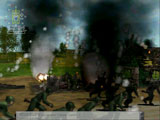 Likewise, the game’s interface is fairly intuitive and easy
to use once you figure it out. But figuring it out is a nightmare. Again, this is mostly
the fault of abysmal documentation. While the game includes a nifty “mouse tank”
feature that allows you to access many functions by pointing and clicking, I use a
joystick and keyboard combo, and I was constantly searching for key commands in the
manual. That’s right, in the manual. There is no keyboard command sheet, and as the
commands are spread out over four pages in the manual, it took a lot of fumbling before I
got the hang of things. Look, I don’t want to flog a dead horse here, but I truly
admire this game and would love to see it succeed. Unfortunately, I can see a lot of
disgruntled gamers returning it after a few frustrating hours, and that just breaks my
heart. Likewise, the game’s interface is fairly intuitive and easy
to use once you figure it out. But figuring it out is a nightmare. Again, this is mostly
the fault of abysmal documentation. While the game includes a nifty “mouse tank”
feature that allows you to access many functions by pointing and clicking, I use a
joystick and keyboard combo, and I was constantly searching for key commands in the
manual. That’s right, in the manual. There is no keyboard command sheet, and as the
commands are spread out over four pages in the manual, it took a lot of fumbling before I
got the hang of things. Look, I don’t want to flog a dead horse here, but I truly
admire this game and would love to see it succeed. Unfortunately, I can see a lot of
disgruntled gamers returning it after a few frustrating hours, and that just breaks my
heart.
I have a few other quibbles with the game; wingman AI is usually pretty good, and the
tanks in your platoon are very good at keeping up with you, but they can behave with
suicidal stupidity when changing formation, often presenting rear and flank shots to enemy
troops while maneuvering. And they never seem to use reverse. Enemy AI is often very good,
though infantry probably charges tanks a little too readily. Finally, artillery is way too
deadly. Arty strikes can take out whole sections of cities, and you’ll end many a
mission with your own tank destroyed or immobilized by enemy arty. Finally, the game does
have some bugs, though the most recent patch (1.06) seems to have fixed most of them, and
since installing the patch I’ve run the game without any crashes.
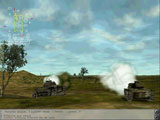 But even though flawed,
Panzer Elite is still an excellent game. If the manual had even been halfway decent, I’d
have given this game five stars. It’s deep, it’s realistic, and it’s fun.
The graphics aren’t stellar, but they’re good enough, and the campaigns and
scenarios reward smart gameplay. I’m looking forward to a East Front installment—this
time with a tutorial and a manual worth the paper it’s printed on. But even though flawed,
Panzer Elite is still an excellent game. If the manual had even been halfway decent, I’d
have given this game five stars. It’s deep, it’s realistic, and it’s fun.
The graphics aren’t stellar, but they’re good enough, and the campaigns and
scenarios reward smart gameplay. I’m looking forward to a East Front installment—this
time with a tutorial and a manual worth the paper it’s printed on.
--Rick Fehrenbacher |

 World War II tank simmers have
waited a long time for a realistic and fun simulation of armored combat during The Big
One. Though last year brought two offerings--SSI’s Panzer Commander and Interactive
Magic’s iPanzer ’44—both had serious shortcomings, and didn’t capture
the imagination of either casual gamers or the hardcore. This was especially rankling to
tank simmers when they considered the numerous quality World War II air combat sims that
appeared last year. Stuck without a decent game of their own, gamers could only look to
one slim remaining hope—Psygnosis and Wings Simulations’ long-delayed Panzer
Elite. Well, treadheads, look no further—Panzer
Elite is by far the best World War II tank sim ever—it’s realistic, it’s
fun, and it absolutely captures the “feel” of tank combat. That’s not to
say it doesn’t have some problems—it’s a little buggy out of the box, the
manual is inexcusably insufficient, the AI can be less than intelligent, and the graphics
are a mixed bag. But overall this is a superior game engine and a terrific game.
World War II tank simmers have
waited a long time for a realistic and fun simulation of armored combat during The Big
One. Though last year brought two offerings--SSI’s Panzer Commander and Interactive
Magic’s iPanzer ’44—both had serious shortcomings, and didn’t capture
the imagination of either casual gamers or the hardcore. This was especially rankling to
tank simmers when they considered the numerous quality World War II air combat sims that
appeared last year. Stuck without a decent game of their own, gamers could only look to
one slim remaining hope—Psygnosis and Wings Simulations’ long-delayed Panzer
Elite. Well, treadheads, look no further—Panzer
Elite is by far the best World War II tank sim ever—it’s realistic, it’s
fun, and it absolutely captures the “feel” of tank combat. That’s not to
say it doesn’t have some problems—it’s a little buggy out of the box, the
manual is inexcusably insufficient, the AI can be less than intelligent, and the graphics
are a mixed bag. But overall this is a superior game engine and a terrific game.